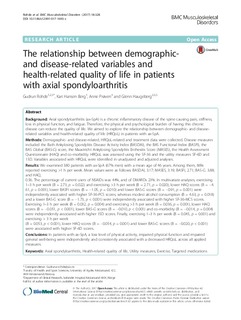| dc.description.abstract | Background
Axial spondyloarthritis (ax-SpA) is a chronic inflammatory disease of the spine causing pain, stiffness, loss in physical function, and fatigue. Therefore, the physical and psychological burden of having this chronic disease can reduce the quality of life. We aimed to explore the relationship between demographic- and disease-related variables and health-related quality of life (HRQoL) in patients with ax-SpA.
Methods
Demographic- and disease-related, HRQoL-related and treatment data were collected. Disease measures included the Bath Ankylosing Spondylitis Disease Activity Index (BASDAI), the BAS Functional Index (BASFI), the BAS Global (BAS-G) score, the Maastricht Ankylosing Spondylitis Enthesitis Score (MASES), the Health Assessment Questionnaire (HAQ) and co-morbidity. HRQoL was assessed using the SF-36 and the utility measures SF-6D and 15D. Variables associated with HRQoL were identified in unadjusted and adjusted analyses.
Results
We examined 380 patients with ax-SpA (67% men) with a mean age of 46 years. Among them, 86% reported exercising >1 h per week. Mean values were as follows: BASDAI, 3.17; MASES, 3.19; BASFI, 2.71; BAS-G. 3.88; and HAQ, 0.56. The percentage of current users of NSAIDs was 44%, and of DMARDs 23%. In multivariate analyses, exercising 1–3 h per week (B = 2.73, p = 0.022) and exercising >3 h per week (B = 2.71, p = 0.020), lower HAQ scores (B = −4.61, p = 0.001), lower BASFI scores (B = −1.05, p = 0.010) and lower BAS-G scores (B = −0.91, p = 0.001) were independently associated with higher SF-36-PCS scores, whereas modest alcohol consumption (B = 4.63, p = 0.018) and a lower BAS-G score (B = −1.73, p < 0.001) were independently associated with higher SF-36-MCS scores. Exercising 1–3 h per week (B = 0.032, p = 0.004) and exercising >3 h per week (B = 0.036, p = 0.001), lower HAQ scores (B = −0.051, p < 0.001), lower BAS-G scores (B = −0.010, p < 0.001) and co-morbidity (B = −0.014, p = 0.004) were independently associated with higher 15D scores. Finally, exercising 1–3 h per week (B = 0.045, p = 0.001) and exercising > 3 h per week (B = 0.053, p < 0.001), lower HAQ scores (B = −0.054, p = 0.001) and lower BAS-G scores (B = −0.020, p < 0.001) were associated with higher SF-6D scores. | nb_NO |

